Capacity Optimal Allocation Method and Frequency Division Energy Management for Hybrid Energy Storage System Considering Grid-Connected Requirements in Photovoltaic System
Abstract
1. Introduction
2. Grid-Connection of PVPS Connected with HESS
2.1. Grid Connection Topology of PV System Connected with HESS
2.2. Overall Design of Control Strategy
- Initializing each required parameter, and the real-time power fluctuations of PV are obtained by using the K-means clustering method introduced in Section 5. Setting the flag bit to zero. When , the PV power has not been smoothed on the day and the data for the next time period need to be updated. When , the PV power has been smoothed that day and the grid-connected power after smoothing can be output. (Corresponds to Part A, Figure 2).
- The dual objective functions and are established based on the minimum annual input cost of HESS and the minimum annual life loss cost of lithium battery. Setting the initial value of independent variable is 0.001 Hz (the cutoff frequency range of HESS is selected in Section 4).
- According to the proposed HESS frequency division control strategy, the power distribution and energy distribution of the battery and supercapacitor are obtained.
- According to the two indicators of power and energy, the target value and the size of the capacity configuration are determined, and the data of the current iteration are stored.
- Determining the size of the cutoff frequency . If the is not equal to 0.0091 Hz, the value of the updated is increased by 0.0001 Hz and steps 3 to 5 are repeated. If is equal to 0.0091 Hz, the update iteration of is stopped, and all objective values in the database are globally optimized. (Step 3–6 correspond to Part C, Figure 2).
- Outputting the value of the minimum target value and the corresponding cutoff frequency .
3. Control Strategy of Grid-Connected PV
3.1. Grid-Connected PV Requirements
3.2. PV MPPT Working Point Switching Control
4. Capacity Optimal Allocation Method and Frequency Division EMS for HESS
4.1. HESS Energy Characteristics
- meeting the maximum required power response;
- meeting the requirement of maximum supply or storage energy.
4.2. Cutoff Frequency Range
4.3. Construction of Objective Function
5. Results and Discussion
5.1. Construction of Typical PV Power Fluctuation Scenarios
- Enter the parameter and the parameter k.
- k data are randomly selected in the dataset as the initial cluster center.
- Calculate the distance between each data and each initial clustering center, and divide the other data into the class where the nearest clustering center is located.
- Calculate the cluster center points of the divided clusters and compare these with the initial data and update.
- The above process is iterated in the subsequent calculation until the data are no longer updated. The clustering process is shown in Figure 6.
5.2. The Power Fluctuation of PVPS
5.3. HESS Power
5.4. Objective Function Solution
5.5. Power and SOC Variation for Lithium Battery and Supercapacitor
6. Conclusions
Author Contributions
Funding
Data Availability Statement
Conflicts of Interest
References
- Kong, L.; Yu, J.; Cai, G. Modeling, control and simulation of a photovoltaic/hydrogen/supercapacitor hybrid power generation system for grid-connected applications. Int. J. Hydrogen Energy 2019, 44, 25129–25144. [Google Scholar] [CrossRef]
- Wang, G.; Li, Z.; Li, J.; Wang, J.; Tian, H. Grid-connected resonance analysis of half-wavelength transmission system with wind power and photovoltaic power supply. Int. J. Electr. Power Energy Syst. 2022, 135, 107568. [Google Scholar] [CrossRef]
- Liang, H.; Han, X.; Yu, H.; Li, F.; Liu, Z.; Zhang, K. Transmission line fault-cause identification method for large-scale new energy grid connection scenarios. Glob. Energy Interconnect. 2022, 5, 362–374. [Google Scholar] [CrossRef]
- Guo, W.; Xu, W. Research on optimization strategy of harmonic suppression and reactive power compensation of photovoltaic multifunctional grid connected inverter. Int. J. Electr. Power Energy Syst. 2023, 145, 108649. [Google Scholar] [CrossRef]
- Silva, J.L.D.S.; Moreira, H.S.; dos Reis, M.V.G.; Barros, T.A.D.S.; Villalva, M.G. Theoretical and behavioral analysis of power optimizers for grid-connected photovoltaic systems. Energy Rep. 2022, 8, 10154–10167. [Google Scholar] [CrossRef]
- Shivashankar, S.; Mekhilef, S.; Mokhlis, H.; Karimi, M. Mitigating methods of power fluctuation of photovoltaic (PV) sources—A review. Renew. Sustain. Energy Rev. 2016, 59, 1170–1184. [Google Scholar] [CrossRef]
- Zhang, J.; Hou, L.; Diao, X.; Yang, X.; Tang, P.; Cao, X. Power allocation method of battery energy storage system considering state balance in smoothing photovoltaic power fluctuations. Front. Energy Res. 2022, 10, 965812. [Google Scholar] [CrossRef]
- Marcos, J.; De La Parra, I.; García, M.; Marroyo, L. Control Strategies to Smooth Short-Term Power Fluctuations in Large Photovoltaic Plants Using Battery Storage Systems. Energies 2014, 7, 6593–6619. [Google Scholar] [CrossRef]
- Tang, R.; Xu, Q.; Fang, J.; Xia, Y.; Shi, Y. Optimal configuration strategy of hybrid energy storage system on industrial load side based on frequency division algorithm. J. Energy Storage 2022, 50, 104645. [Google Scholar] [CrossRef]
- Bai, J.; Zhao, Y.; Jiang, H.; Wei, M.; Yu, S. Load frequency control of power system with energy storage based on disturbance observer. Energy Rep. 2022, 8, 615–622. [Google Scholar] [CrossRef]
- Hannan, M.; Abu, S.M.; Al-Shetwi, A.Q.; Mansor, M.; Ansari, M.; Muttaqi, K.M.; Dong, Z. Hydrogen energy storage integrated battery and supercapacitor based hybrid power system: A statistical analysis towards future research directions. Int. J. Hydrogen Energy 2022, 47, 39523–39548. [Google Scholar] [CrossRef]
- Zhu, F.; Zhou, X.; Zhang, Y.; Xu, D.; Fu, J. A load frequency control strategy based on disturbance reconstruction for multi-area interconnected power system with hybrid energy storage system. Energy Rep. 2021, 7, 8849–8857. [Google Scholar] [CrossRef]
- Saenger, P.; Nathalie, D.; Karine, D.; Marie-Cecile, P.; Raphael, C.; Frederic, G. Optimization of Electrical Energy Storage System Sizing for an Accurate Energy Management in an Aircraft. IEEE Trans. Veh. Technol. 2017, 66, 5572–5583. [Google Scholar] [CrossRef]
- Wang, Y.; Zhang, Y.; Xue, L.; Liu, C.; Song, F.; Sun, Y.; Liu, Y.; Che, B. Research on planning optimization of integrated energy system based on the differential features of hybrid energy storage system. J. Energy Storage 2022, 55, 105368. [Google Scholar] [CrossRef]
- Wang, J.; Wang, B.; Zhang, L.; Wang, J.; Shchurov, N.; Malozyomov, B. Review of bidirectional DC–DC converter topologies for hybrid energy storage system of new energy vehicles. Green Energy Intell. Transp. 2022, 1, 100010. [Google Scholar] [CrossRef]
- Hou, H.; Xu, T.; Wu, X.; Wang, H.; Tang, A.; Chen, Y. Optimal capacity configuration of the wind-photovoltaic-storage hybrid power system based on gravity energy storage system. Appl. Energy 2020, 271, 115052. [Google Scholar] [CrossRef]
- Li, J.; Zhang, Z.; Shen, B.; Gao, Z.; Ma, D.; Yue, P.; Pan, J. The capacity allocation method of photovoltaic and energy storage hybrid system considering the whole life cycle. J. Clean. Prod. 2020, 275, 122902. [Google Scholar] [CrossRef]
- Ding, Y.; Xu, Q.; Yang, B. Optimal configuration of hybrid energy storage in integrated energy system. Energy Rep. 2020, 6, 739–744. [Google Scholar] [CrossRef]
- Argyrou, M.C.; Marouchos, C.C.; Kalogirou, S.A.; Christodoulides, P. A novel power management algorithm for a residential grid-connected PV system with battery-supercapacitor storage for increased self-consumption and self-sufficiency. Energy Convers. Manag. 2021, 246, 114671. [Google Scholar] [CrossRef]
- Dong, H.; Fu, Y.; Jia, Q.; Wen, X. Optimal dispatch of integrated energy microgrid considering hybrid structured electric-thermal energy storage. Renew. Energy 2022, 199, 628–639. [Google Scholar] [CrossRef]
- Etim, N.-B.B.; Giaouris, D. Probabilistic adaptive power pinch analysis for islanded hybrid energy storage systems. J. Energy Storage 2022, 54, 105224. [Google Scholar] [CrossRef]
- Ahmad, F.F.; Ghenai, C.; Hamid, A.K.; Bettayeb, M. Application of sliding mode control for maximum power point tracking of solar photovoltaic systems: A comprehensive review. Annu. Rev. Control. 2020, 49, 173–196. [Google Scholar] [CrossRef]
- Baboo, J.P.; Jakubczyk, E.; Yatoo, M.A.; Phillips, M.; Grabe, S.; Dent, M.; Hinder, S.J.; Watts, J.F.; Lekakou, C. Investigating battery-supercapacitor material hybrid configurations in energy storage device cycling at 0.1 to 10C rate. J. Power Sources 2023, 561, 232762. [Google Scholar] [CrossRef]
- Wang, Y.; Song, F.; Ma, Y.; Zhang, Y.; Yang, J.; Liu, Y.; Zhang, F.; Zhu, J. Research on capacity planning and optimization of regional integrated energy system based on hybrid energy storage system. Appl. Therm. Eng. 2020, 180, 115834. [Google Scholar] [CrossRef]
- Pelosi, D.; Baldinelli, A.; Cinti, G.; Ciupageanu, D.-A.; Ottaviano, A.; Santori, F.; Carere, F.; Barelli, L. Battery-hydrogen vs. flywheel-battery hybrid storage systems for renewable energy integration in mini-grid: A techno-economic comparison. J. Energy Storage 2023, 63, 106968. [Google Scholar] [CrossRef]
- Devillers, N.; Marie-Cécile, P.; Daniel, B.; Marie-Laure, G. Influence of the Energy Management on the Sizing of Electrical Energy Storage Systems in an Aircraft. J. Power Sources 2014, 270, 391–402. [Google Scholar] [CrossRef]
- Manas, M.; Dakka, O.; Sharma, S.; Arandhakar, S.; Kallelapu, R.; Golla, S. A novel metaheuristic-based robust unified control MPPT algorithm for grid-connected PV system. Electr. Power Syst. Res. 2023, 221, 109389. [Google Scholar] [CrossRef]
- Ma, W.; Wang, W.; Wu, X.; Hu, R.; Tang, F.; Zhang, W. Control Strategy of a Hybrid Energy Storage System to Smooth Photovoltaic Power Fluctuations Considering Photovoltaic Output Power Curtailment. Sustainability 2019, 11, 1324. [Google Scholar] [CrossRef]
- Snoussi, J.; Ben Elghali, S.; Benbouzid, M.; Mimouni, M.F. Optimal Sizing of Energy Storage Systems Using Frequency-Separation-Based Energy Management for Fuel Cell Hybrid Electric Vehicles. IEEE Trans. Veh. Technol. 2018, 67, 9337–9346. [Google Scholar] [CrossRef]
- Su, H.; Yang, J.; Du, X.; Wang, Z.; Li, Y. Configuration of community hybrid energy storage system based on retired power battery. Energy Rep. 2020, 6, 934–942. [Google Scholar] [CrossRef]
- He, G.; Chen, Q.; Kang, C.; Pinson, P.; Xia, Q. Optimal Bidding Strategy of Battery Storage in Power Markets Considering Performance-Based Regulation and Battery Cycle Life. IEEE Trans. Smart Grid 2015, 7, 2359–2367. [Google Scholar] [CrossRef]



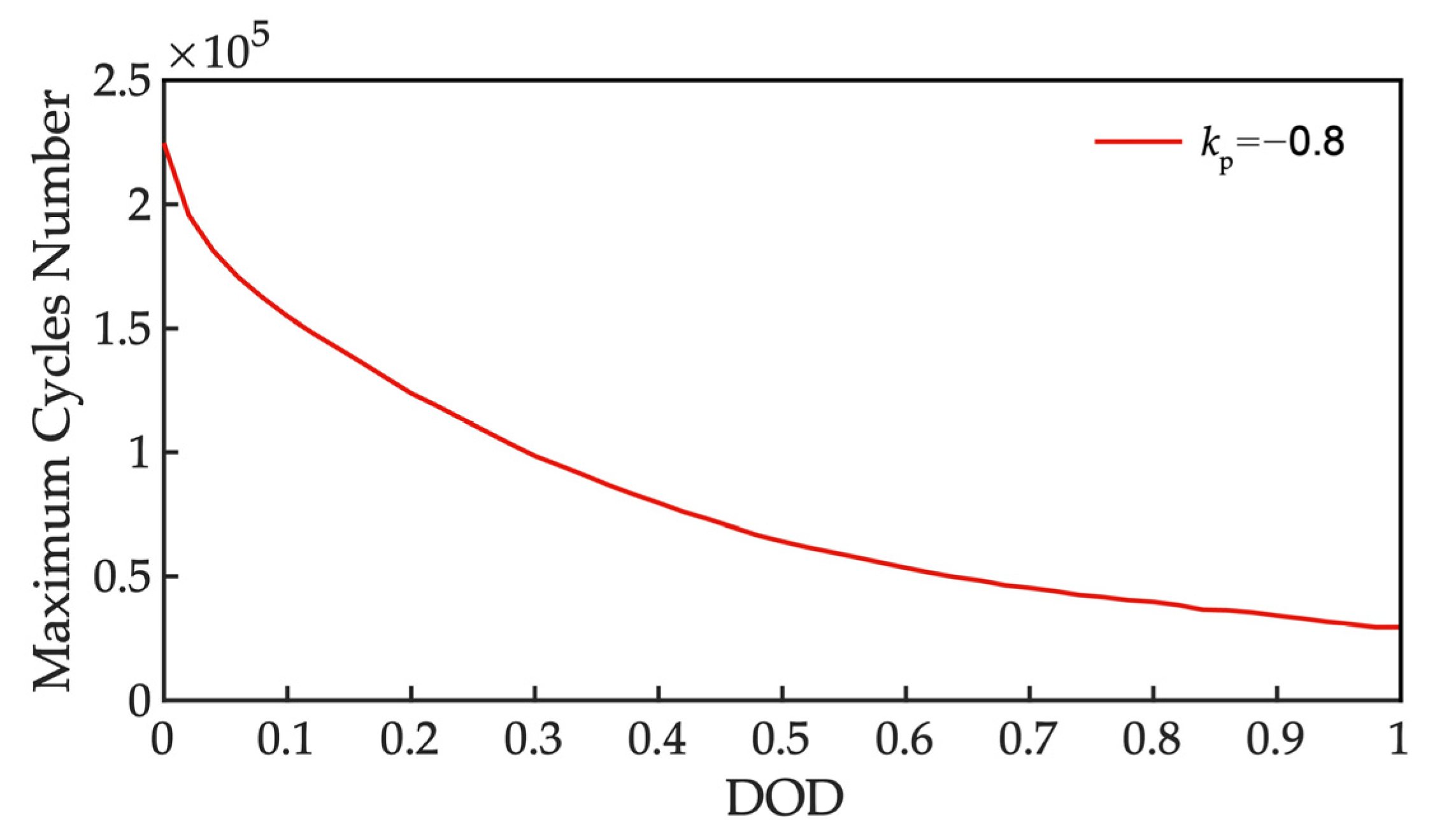
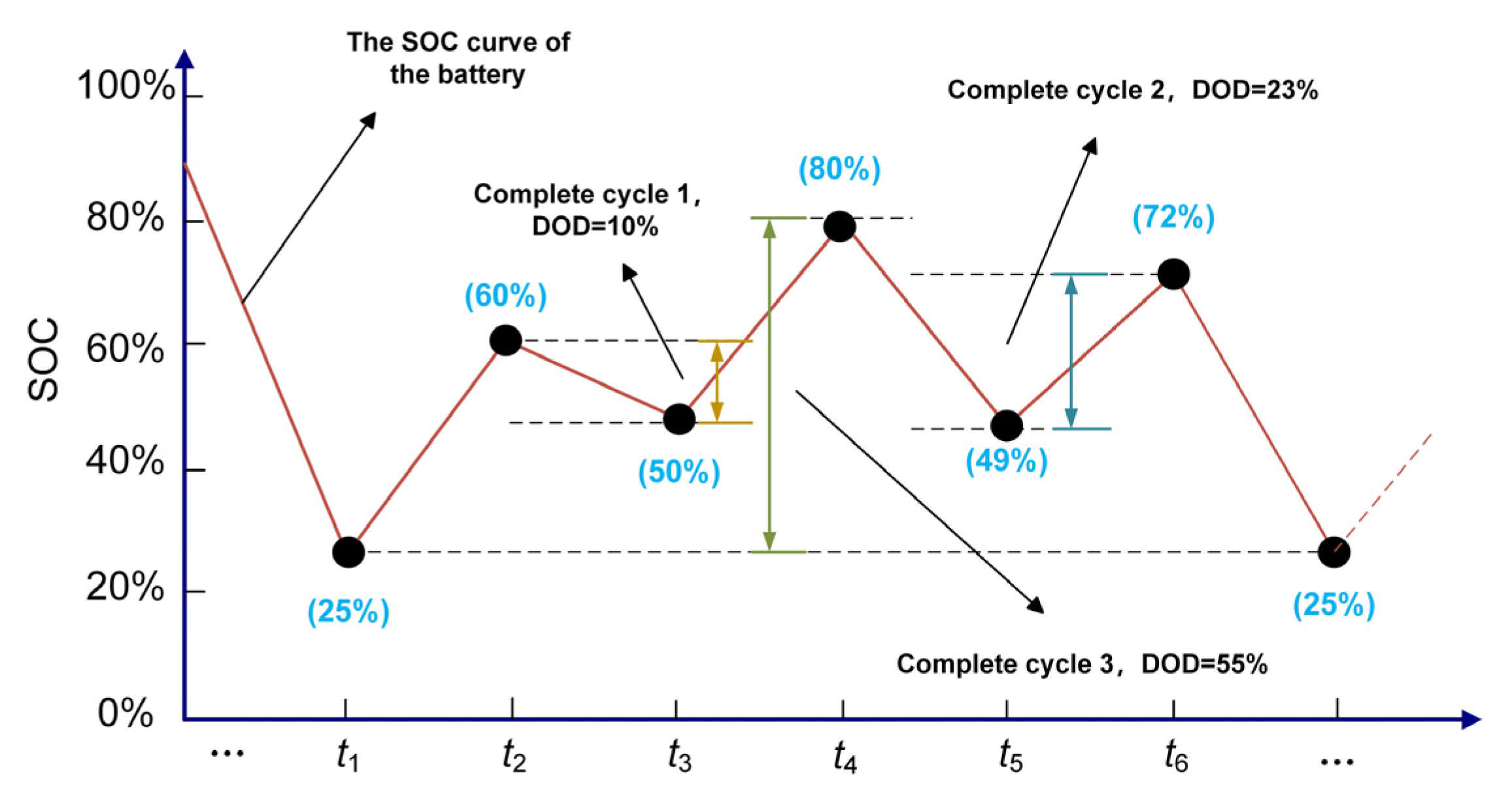
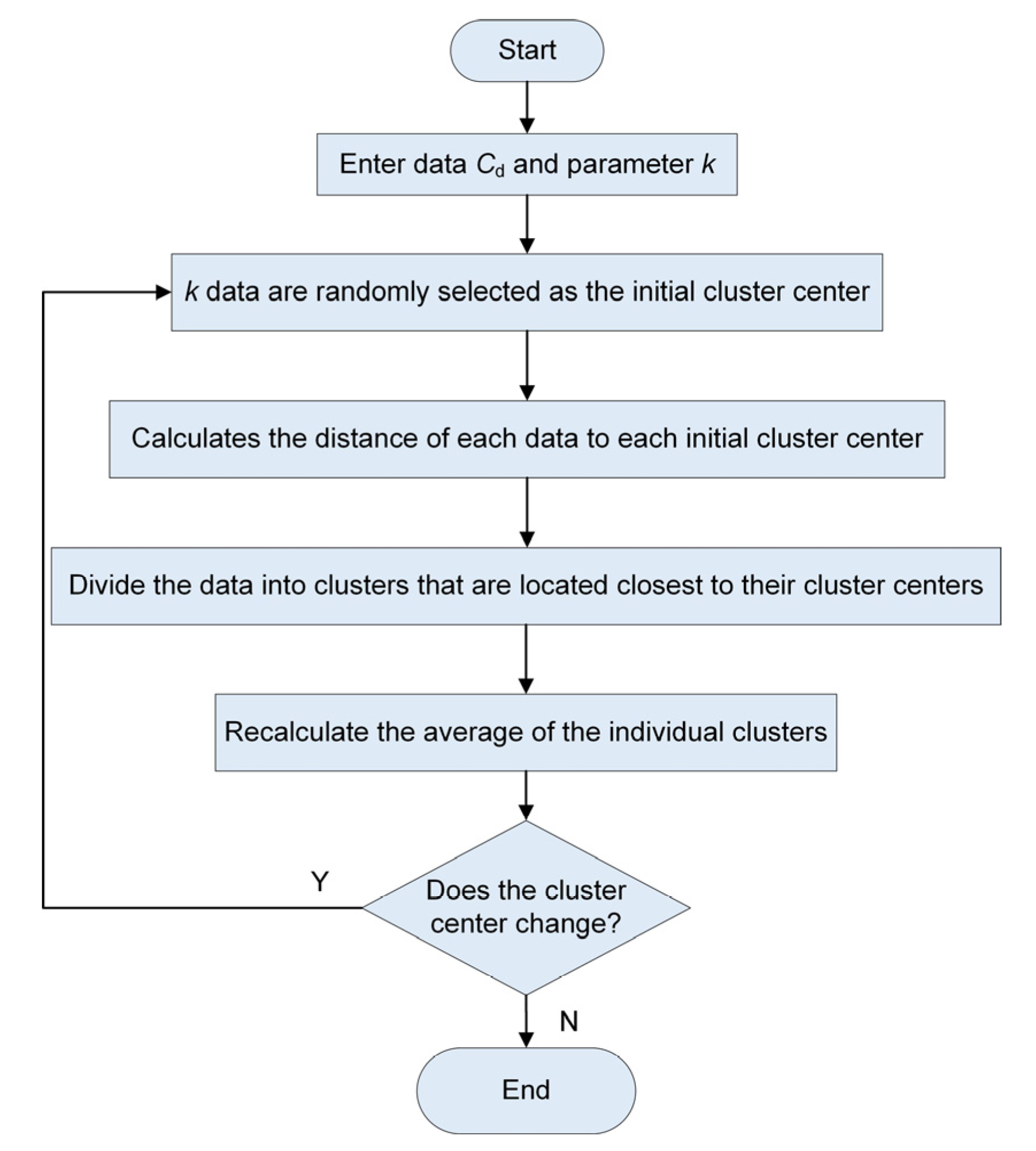
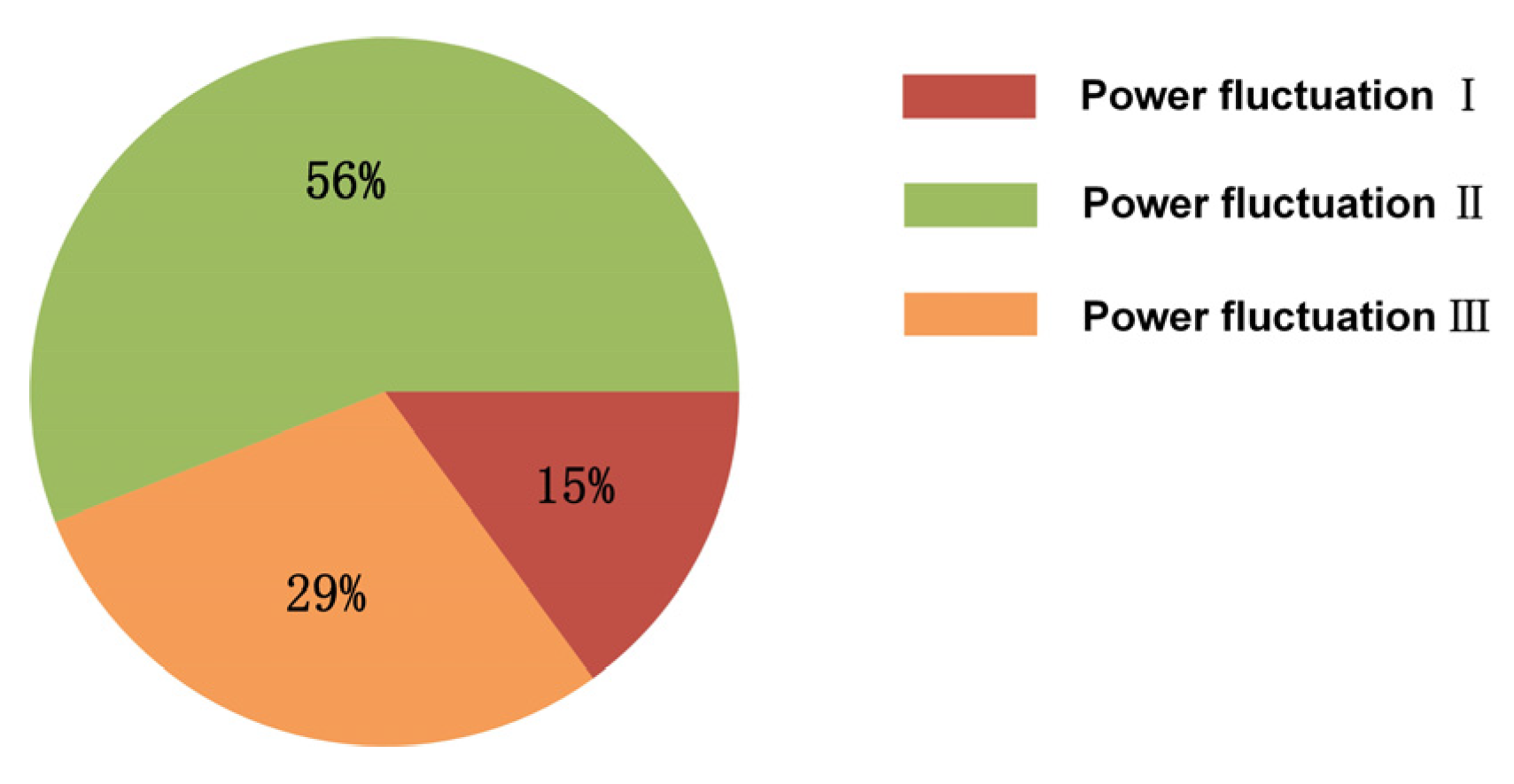

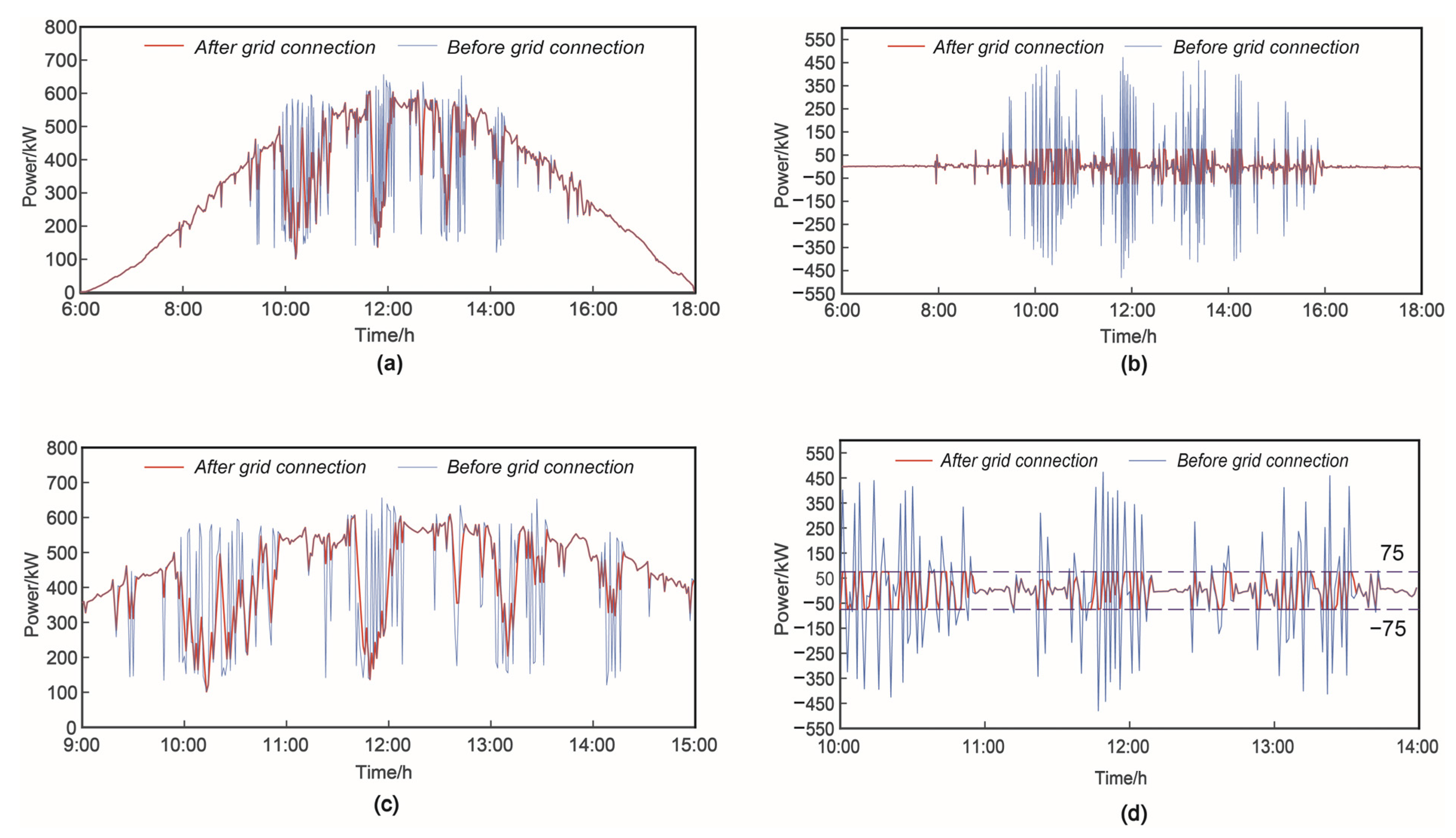


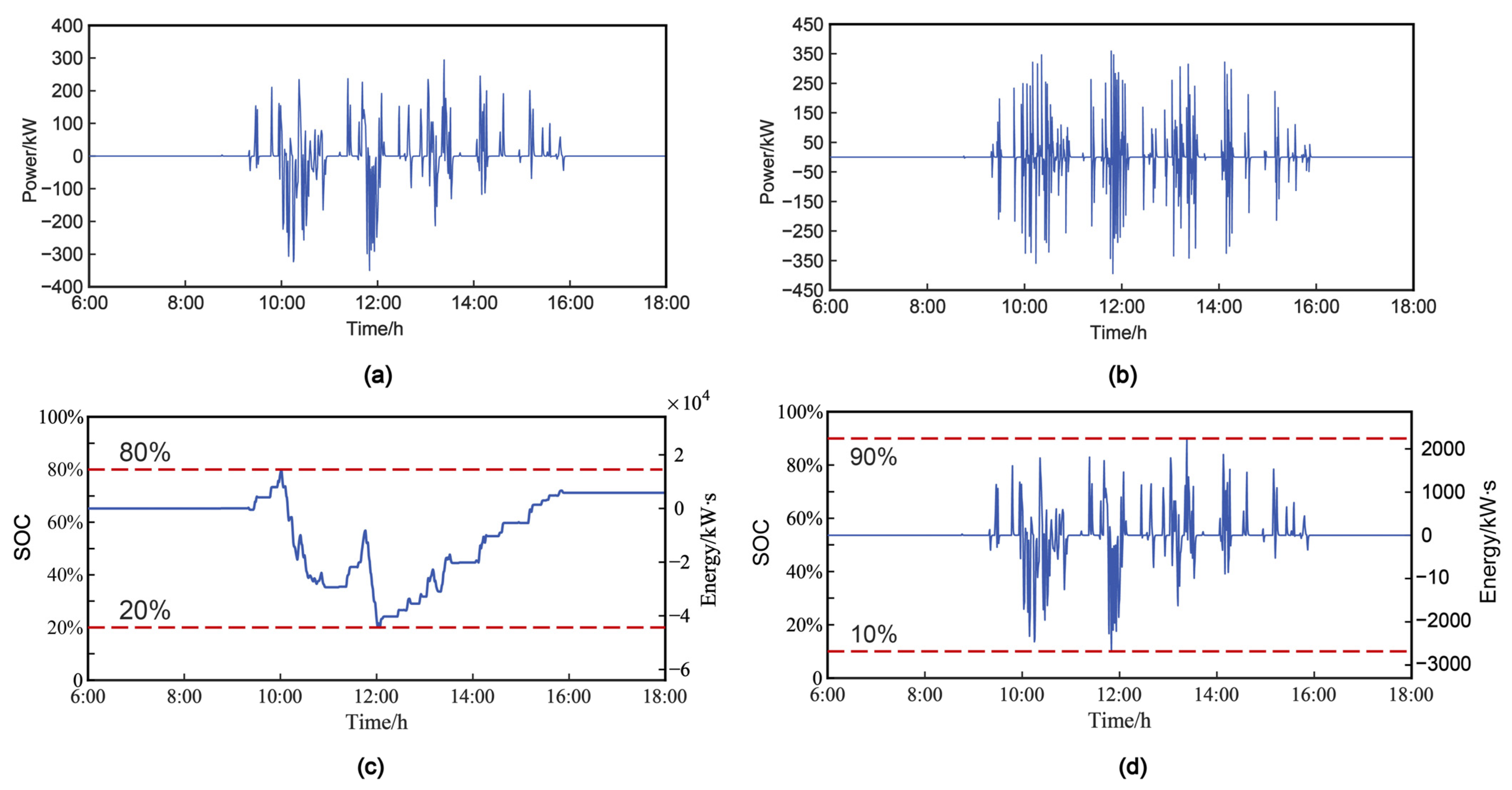
| Parameter | Symbol | Setting Values |
|---|---|---|
| PV installed capacity | 750 (kWp) | |
| Sampling interval | 1 (min) | |
| PV power fluctuation range | ±75 (kW/min) |
| Symbol | Lithium Battery (3.7 V/5.2 Ah) | Symbol | Supercapacitor (2.7 V/500 F) |
|---|---|---|---|
| 17.02 (Wh) | 0.45 (Wh) | ||
| 355.35 (W) | 562.5 (W) | ||
| 3859 (RMB/kWh) | 39,265 (RMB/kWh) | ||
| 2700 (RMB/kW) | 2300 (RMB/kW) | ||
| 1.92 (RMB/kWh) | 19.63 (RMB/kWh) | ||
| 1.35 (RMB/kW) | 1.15 (RMB/kW) | ||
| 10 (year) | 20 (year) | ||
| z | 0.06 | z | 0.06 |
| kp | −0.8 | / | / |
| Parameter | Symbol | Result |
|---|---|---|
| Cutoff frequency (Hz) | 0.0066 | |
| Annual comprehensive input cost (RMB) | / | 0.93 × 107 |
| Annual input cost (RMB) | 4.82 × 106 | |
| Annual life loss cost (RMB) | 4.51 × 106 | |
| Lithium battery quantity | 5552 | |
| Supercapacitor quantity | 9773 |
Disclaimer/Publisher’s Note: The statements, opinions and data contained in all publications are solely those of the individual author(s) and contributor(s) and not of MDPI and/or the editor(s). MDPI and/or the editor(s) disclaim responsibility for any injury to people or property resulting from any ideas, methods, instructions or products referred to in the content. |
© 2023 by the authors. Licensee MDPI, Basel, Switzerland. This article is an open access article distributed under the terms and conditions of the Creative Commons Attribution (CC BY) license (https://creativecommons.org/licenses/by/4.0/).
Share and Cite
Li, W.; Jin, R.; Ma, X.; Zhang, G. Capacity Optimal Allocation Method and Frequency Division Energy Management for Hybrid Energy Storage System Considering Grid-Connected Requirements in Photovoltaic System. Energies 2023, 16, 4154. https://doi.org/10.3390/en16104154
Li W, Jin R, Ma X, Zhang G. Capacity Optimal Allocation Method and Frequency Division Energy Management for Hybrid Energy Storage System Considering Grid-Connected Requirements in Photovoltaic System. Energies. 2023; 16(10):4154. https://doi.org/10.3390/en16104154
Chicago/Turabian StyleLi, Wei, Ruixin Jin, Xiaoyong Ma, and Guozun Zhang. 2023. "Capacity Optimal Allocation Method and Frequency Division Energy Management for Hybrid Energy Storage System Considering Grid-Connected Requirements in Photovoltaic System" Energies 16, no. 10: 4154. https://doi.org/10.3390/en16104154
APA StyleLi, W., Jin, R., Ma, X., & Zhang, G. (2023). Capacity Optimal Allocation Method and Frequency Division Energy Management for Hybrid Energy Storage System Considering Grid-Connected Requirements in Photovoltaic System. Energies, 16(10), 4154. https://doi.org/10.3390/en16104154






